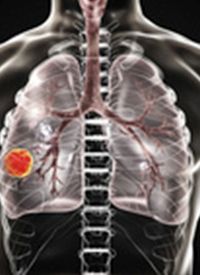Article
Ivonescimab Receives Breakthrough Therapy Designation for IO-Resistant NSCLC in China
Author(s):
The Center for Drug Evaluation of the China National Medical Products Administration has granted a breakthrough therapy designation to ivonescimab plus docetaxel for patients with locally advanced or metastatic non–small cell lung cancer who failed to respond to a prior PD-(L)1 inhibitor plus platinum-based doublet chemotherapy.

The Center for Drug Evaluation of the China National Medical Products Administration has granted a breakthrough therapy designation (BTD) to the combination of ivonescimab (AK112) and docetaxel for the treatment of patients with locally advanced or metastatic non–small cell lung cancer (NSCLC) who failed to respond to a prior PD-(L)1 inhibitor plus platinum-based doublet chemotherapy, according to an announcement from Akeso Biopharma.1
Notably, ivonescimab is the only drug candidate that has received BTD for PD-L1/PD-1–resistant lung cancer in China, according to the company.
This represents the third BTD for ivonescimab in NSCLC. The other two BTDs include:
- Ivonescimab plus chemotherapy for the treatment of patients with EGFR-mutated locally advanced or metastatic NSCLC who have failed to respond to an EGFR TKI, and
- Ivonescimab as a first-line treatment for patients with locally advanced or metastatic PD-L1–positive NSCLC.
Ivonescimab is a first-in-class PD-1/VEGF bispecific antibody. Engineered with Tetrabody technology, ivonescimab blocks PD-1 binding to PD-L1 and PD-L2, and blocks VEGF binding to VEGF receptors.
PD-1 inhibitors combined with VEGF inhibitors have shown robust efficacy in several tumor types, including renal cell carcinoma, NSCLC, and hepatocellular carcinoma. The use of ivonescimab monotherapy to inhibit PD-1 and VEGF co-expression in the tumor microenvironment may block these 2 pathways more effectively and enhance the antitumor activity compared with combination therapy.
Prior findings from a multicenter, open-label, phase 1b/2 trial (NCT04900363) presented at the 2022 ASCO Annual Meeting demonstrated that ivonescimab monotherapy was safe and well tolerated in patients with advanced NSCLC regardless of histology.2
The rate of grade 3/4 treatment-related adverse effects (TRAEs) was 13.5%. No TRAEs led to permanent treatment discontinuation.
In terms of efficacy, among 54 treatment-naïve patients with a PD-L1 tumor proportion score (TPS) of at least 1% with at least 1 post-treatment tumor assessment, the objective response rate (ORR) was 50.0%. The disease control rate (DCR) was 93%.
Among 50 treatment-naïve patients receiving more than 10 mg/kg of ivonescimab every 3 weeks, the ORR among patients with TPS of 1% or greater, 1% to 49%, and 50% or above was 60.0%, 50.0%, and 76.9%, respectively. The DCR in these respective cohorts was 1%, 95.5%, and 100.0%.
As of March 4, 2022, 96 patients were enrolled, 90 of whom had at least one post-treatment tumor assessment. The dose-selection part was divided into four different dosing regimens including 10 mg/kg every 3 weeks, 20 mg/kg every 2 weeks, 20 mg/kg every 3 weeks or 30 mg/kg every 3 weeks. Safety and ORR served as the primary end points.
In another phase 2 trial comprised of 3 cohorts, investigators evaluated ivonescimab in combination with chemotherapy in previously untreated advanced patients with NSCLC patients without EGFR/ALK alterations (cohort 1); patients with advanced NSCLC who failed a prior EGFR TKI (cohort 2); and patients with advanced NSCLC who failed prior platinum-based doublet chemotherapy with anti-PD-1/PD-L1 antibody (cohort 3).3
As of March 20, 2022, 83 patients with advanced NSCLC had been treated with the combination for up to 12 months. The average dosing time was 7.56 months.
In cohort 1, the median progression-free survival (PFS) was not reached, and the 6-month PFS rate was 78.8%. In patients with squamous NSCLC, the ORR was 77.8%, the DCR was 100%, and the 6-month PFS rate was 83.3%.
In cohort 2, the ORR and DCR were 68.4% and 94.7% respectively. The median PFS was 8.2 months and the 6-month PFS rate was 69.3%.
In cohort 3, the ORR was 40.0% and the DCR was 80%. The median PFS was 6.6 months and the 6-month PFS rate was 51.1%.
Currently, Akeso is conducting a phase 3 trial of ivonescimab monotherapy vs pembrolizumab (Keytruda) monotherapy as a first-line treatment for patients with PD-L1–positive NSCLC. Additionally, the company is conducting an ongoing phase 3 trial (NCT05184712) of ivonescimab plus chemotherapy vs chemotherapy in EGFR-mutated, advanced nonsquamous NSCLC that failed a prior EGFR TKI.
Ivonescimab is also being investigated in various other stages of NSCLC and small cell lung cancer.
References
- Akeso’s Ivonescimab (PD-1/VEGF bispecific antibody, AK112) granted breakthrough therapy designation for I-O resistance NSCLC patients in China. News release. Akeso, Biopharma. November 13, 2022. Accessed November 16, 2022. https://prn.to/3tx62MK
- Akeso releases promising data of Ivonescimab (PD-1/VEGF BsAbs, AK112) for advanced NSCLC at ASCO 2022. News release. June 6, 2022. Accessed November 16, 2022. https://www.akesobio.com/en/media/akeso-news/20220606-2/
- Akeso releases promising data of Ivonescimab (PD-1/VEGF BsAbs, AK112) combined with chemotherapy in advanced NSCLC at ASCO 2022. News release. Akeso, Inc. June 5, 2022. Accessed November 16, 2022. https://prn.to/3UKSppo

EMA Validates Application for Nivolumab Plus Ipilimumab in Frontline HCC








